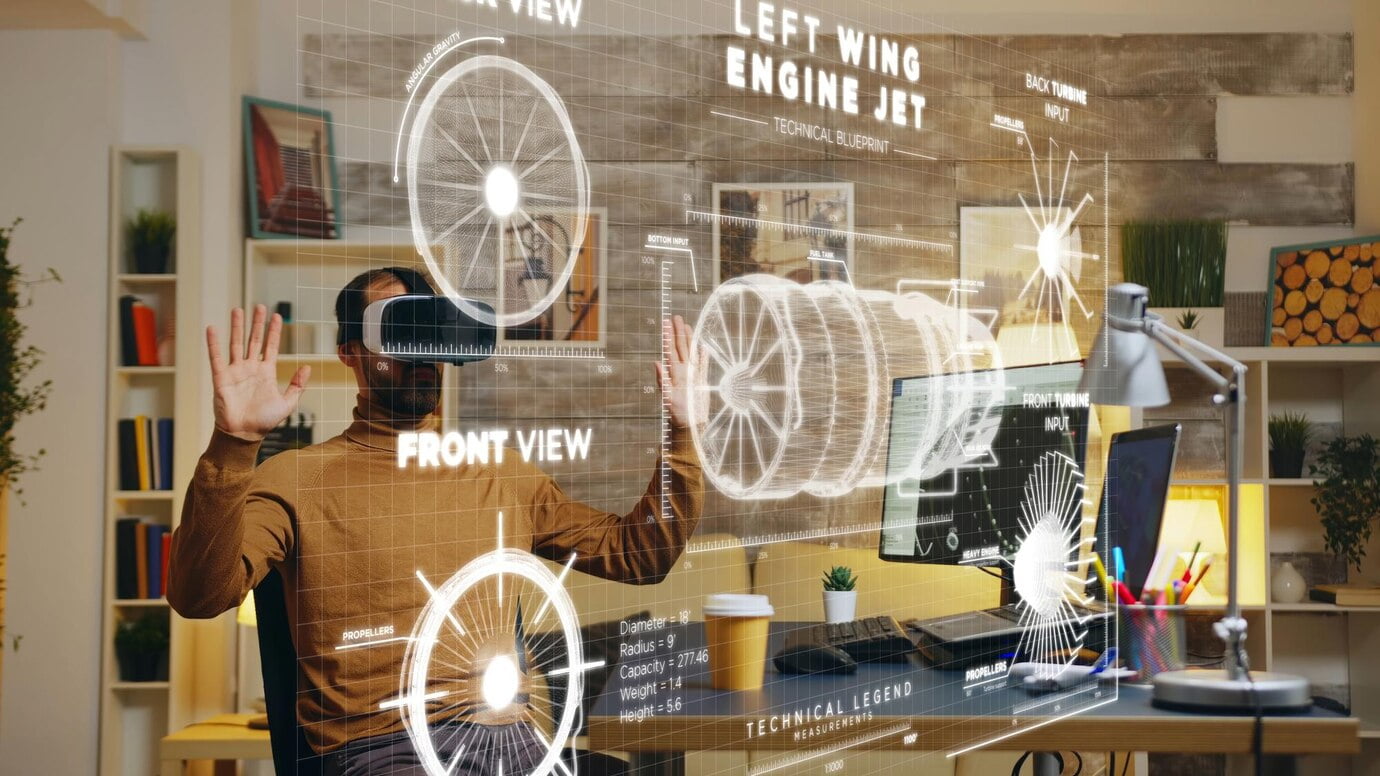Augmented reality (AR) has revolutionized the way we interact with the digital world, especially in the social networks. With the ability to superimpose virtual information on the real world, AR offers an immersive and interactive experience that is transforming marketing and business communication.

Thanks to this feature, this technology has been widely used on social media platforms, where it has become an innovative tool for boosting business. In this article, you'll see how to take advantage of all the benefits of augmented reality on social media. Follow along!
What is augmented reality?
AR is a technology that combines the real world with virtual elements, creating an immersive and interactive experience.
Unlike virtual reality (VR), which completely replaces the real environment with a digital one, augmented reality adds virtual layers to the physical world.
Using devices such as smartphones, tablets or special glasses, AR allows users to see their surroundings with additional information projected on the screen or in the field of vision.
This creates an integrated experience that expands human capabilities, providing new forms of interaction and engagement.
How does it work?
Although it seems like "something from another world" and varies depending on the application and device used, augmented reality works very simply.
In fact, AR works through software that recognizes images, objects or spatial coordinates in the real world and then generates graphics, sounds or videos that integrate with these references.
How is that possible? We'll explain! All this magic happens thanks to cameras and sensors that capture the environment and allow the software to position the virtual elements precisely.
Technically speaking, how AR works generally involves three main stages: tracking, detection and rendering.
- Tracking: a stage that involves recognizing and accurately tracking reference points in the real world, such as markers or specific surfaces. This allows the device to understand the user's position and orientation in relation to the environment.
- Detection: once the environment has been traced, the next step is to detect specific objects or surfaces where the virtual elements will be superimposed. This may involve recognizing patterns or distinctive features to identify the appropriate location for rendering the virtual elements.
- Rendering: finally, the virtual elements are superimposed on the real environment, taking into account the correct position, orientation and scale. This creates the illusion that these elements are part of the real world, providing an immersive and interactive experience.
Application of augmented reality in marketing
The application of augmented reality on social networks goes far beyond providing immersive and interactive moments of socialization. In the context of marketing, the technology offers brands an innovative way to stand out and engage consumers. Some of the most common applications include:
- Product experiences: brands can use AR to allow consumers to visualize products in their environment before making a purchase, such as seeing how a piece of furniture would look in their living room or trying on clothes and accessories virtually.
- Brand activations: companies can create unique augmented reality experiences for events and brand activations, offering participants a memorable and shareable experience that reinforces the brand's identity and values.
- Interactive advertisingtechnology-based ads can provide a more engaging and interactive experience for consumers, allowing them to interact with virtual content in a creative and immersive way.

Augmented reality on social networks
Social platforms have adopted augmented reality to improve the user experience, offer new forms of interaction and reach and engage their target audiences in innovative ways.
Filters that modify the face, interactive games and 3D product visualizations are just some of the applications of augmented reality on social networks.
Contrary to popular belief, these tools don't just entertain users. They also offer companies new opportunities for engagement and conversion.
Impacts on consumer communication
Augmented reality on social networks is transforming the way brands communicate with consumers, providing more immersive, interactive and personalized experiences. By offering AR content in their communication strategies, brands can:
- Increase consumer engagement: AR experiences are highly engaging and shareable, encouraging users to interact with brand content in meaningful and memorable ways.
- Strengthening the brand: augmented reality applications on social networks can help brands stand out from the competition by reinforcing their identity and values in a unique and innovative way.
- Boosting sales: by giving consumers a more immersive and realistic experience of products, AR can increase trust and the likelihood of purchase, boosting sales and return on marketing investment.
Benefits of augmented reality for companies
AR has many benefits for companies. In addition to providing a user experience differentiatedaugmented reality can:
- Increase conversion rates;
- Strengthen brand identity;
- Collect valuable data on consumer behavior;
- Encourage the sharing of content on social networks, expanding the reach of campaigns.
Challenges of implementing augmented reality on social networks
AR has proven to be a promising tool for social networks, offering immersive and interactive experiences that can transform the way brands communicate with their audiences.
However, the implementation of this technology comes with a series of challenges that need to be overcome if its potential is to be fully realized. Here are some of them:
Cost and accessibility
One of the main obstacles to the widespread adoption of AR is the cost associated with developing high-quality applications and filters.
In addition, the need for devices with advanced processing capabilities may limit access to these experiences to users with high-end smartphones only.
Technical complexity
Creating augmented reality experiences on social networks also involves significant technical complexity.
The strategy requires professionals with specialized skills in graphic design, programming and data analysis. However, finding talent with these skills and building your own team can be a challenge for many companies.
User experience
Remember that for AR to be effective, it must be intuitive and add value to the user experience.
This means that developers must ensure that AR applications are easy to use and that the virtual elements integrate seamlessly into the real world, without causing confusion or frustration.
ROI measurement
Measuring return on investment (ROI) in AR campaigns can be tricky. Although the technology can increase brand engagement and visibility, translating this into direct sales or other quantifiable indicators can be challenging.
Despite these challenges, augmented reality on social media offers incredible opportunities for companies to innovate in their marketing and communication strategies.
As technology continues to advance and these obstacles are overcome, AR has the potential to become an integral part of the way we interact with brands and each other in the digital environment.
And companies that successfully overcome these challenges will be one step ahead of the competition in digital marketing.
Conclusion
As we presented in this article, the use of augmented reality on social networks is redefining the way brands connect and interact with consumers, offering more immersive, engaging and personalized experiences.
By integrating AR into their social media marketing strategies, brands can differentiate themselves, boost user engagement and drive sales significantly.
AT CMLO&COWe are committed to helping brands harness the full potential of augmented reality to boost their business. Follow us on Facebook, Instagram, LinkedIn and Youtube to stay on top of the latest trends in digital marketing and technology.







